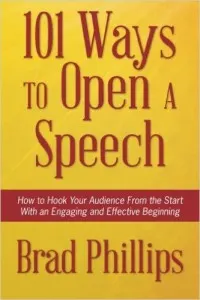 The opening moments of a presentation are critical to its overall success. People form opinions about speakers quickly, and once they do, their first impressions can prove difficult to reverse. Whether you’re giving a report to your board of directors or a speech to a company-wide town hall meeting, nailing your open is important.
The opening moments of a presentation are critical to its overall success. People form opinions about speakers quickly, and once they do, their first impressions can prove difficult to reverse. Whether you’re giving a report to your board of directors or a speech to a company-wide town hall meeting, nailing your open is important.
101 Ways to Open a Speech by Brad Phillips will introduce you to a broad range of speech starters, using dozens of real-life examples. There are different opens intended to surprise, persuade, motivate, engage, and amuse your audiences.
As an exclusive to Working Capital Review readers, Philips has allowed us to excerpt two of his opens below. It’s a book you’ll use over and over again.
The Big Picture Open
Many people begin with a rather bland description of their company, organization, or government agency when speaking to audiences unfamiliar with their work. That’s problematic for two reasons: the open is unengaging, and it’s all about the speaker.
For example, many people begin with something like this:
“Good morning. For those of you who don’t know me, my name is Bill Williams, and I’m the policy director for the Association for the Advancement of Arkansas Education. AAAE is a 501(c)3 nonprofit organization with 25 employees working in four statewide offices to improve elementary and secondary education here in Arkansas.”
That introduction provides useful information, but it focuses solely on what the organization is. In the big picture open, you’ll focus first on why your work matters, which creates a more meaningful framing than simply relying on the what.
“Here in Arkansas, we rank 50th in the United States in high school graduation rates. That means our students are among the least prepared in the nation when entering the workforce and the most likely to live in poverty for the rest of their lives. The Association for the Advancement of Arkansas Education is dedicated to changing that—and to making sure that our students get the high-quality education they need to successfully compete in the global marketplace. My name is Bill Williams, and I’m the policy director for AAAE.”
The second version likely grabbed your attention more than the first. That’s because the second open provided more context and immediately answered the unspoken question all audience members ask themselves: “Why should I care about this?”
The Relevance Open
If you find yourself speaking to an audience that questions whether your topic is relevant to their lives, you might begin with an open that dampens their skepticism and makes your subject’s pertinence clear.
To demonstrate how easy it can be to draw a connection between your topic and an audience’s interests—even when the two seem impossibly far apart—I’ve chosen an extreme example.
Let’s say you’re an art history expert who has been invited to speak to a university business class filled with future entrepreneurs. At first, you might struggle with how to make your topic—art history—relevant to impending “masters of the universe” who think in terms of start-ups, private equity, and corporate takeovers.
As you review your notes from speeches you’ve given in the past, you come across an example about an ancient Chinese sculptor who was considered an oddball by his neighbors. His art pushed community boundaries—and his fellow citizens, unaccustomed to such provocation, rejected him and forced him to live the life of an outcast.
But centuries after his death, that sculptor’s work still survives, displayed prominently in museums around the world. It turns out that he wasn’t an oddball but a visionary, misunderstood by his contemporaries but valued by future generations.
That theme—fighting against societal norms and bringing your vision to market despite the naysayers—can apply to anyone, including budding entrepreneurs. You could follow such an open with examples of other artists and collectors who faced similar obstacles but persevered, and end your talk with “lessons learned” from the art world that apply directly to today’s cutting-edge business students.
